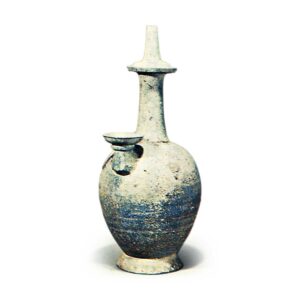
This is the largest group of Sue ware kiln sites in Japan, where a large amount of Sue ware was fired from the end of the Nara Period to the Heian Period. The Iwasaki area stretches 7 km east to west and 5 km north to south on the hills north of the Tenpaku River basin, and includes Nagakute Village, Nisshin Town, Aichi County, Aichi Prefecture, and part of Nagoya City. Sixty kiln sites are known, including Sue ware and vessel kilns. The Orito area is the center of the Sanage Kiln Site County, and is located on the hills between the Tenpaku River and the Sakai River.
It is located in the Jobei area and belongs to Nisshin Town and Togo Village in Aichi County. Seventy-six kilns are known, including Sue ware and Ji ware kilns. The Kurozasa area is located in the eastern part of Sanage Kiln Site County, and is divided into two groups: one belonging to the hills upstream of the Sakai River and the southern part of Miyoshi Town, Nishikamo County, and part of Togo Village, Aichi County and Toyota City, and the other belonging to southern Miyoshi Town on the hills between the Sakai River and the Aizuma River, Igatani, Kariya City and Takaoka Town, Toyota City. There are 162 known kilns, including Sue ware and Ji ware kilns. The Narumi area is located in the southwestern hills between the Sakai and Tenpaku Rivers, and belongs to Hirabari, Tenpaku-cho, Showa-ku, Midori-ku, Midori-ku, Nagoya City, Togo Village, Aichi County, and Toyoake Town, Aichi County. 50 kilns are known, including Sueki and Ji-ware kilns. Four of them are green glazed pottery kilns. The Sue ware from the Sanage kiln has the same form as Kofun period Sue ware: but unlike this type, it is fired in a kiln with the same characteristics as that used in the Ji ware kiln, and most of the pieces have a grayish-white skin tone. They are made by elaborate wheel-thrown molding, and the jars are thin-walled, although the taki-technique is used. The kiln tools also indicate that advanced kiln technology was used. There are many types of pottery with dark green glaze, including water jars, purification jars, long-necked jars, multiceramic jars, fireplace incense burners, heishi pottery horses, pottery inkstones, pottery, pottery pillows, spittoon pots, jars, bottles, bowls, plates, vessels, grudges, and bowls, with as many as 100 types of pottery excavated when classified by purpose of use. (Sizuo Honda, Sanage Kiln, The Complete Collection of Pottery)



